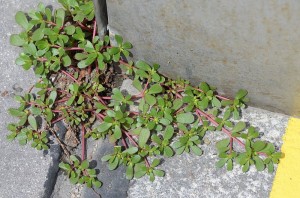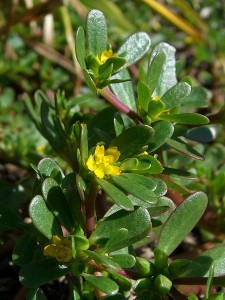
Purslane(Portulaca oleracea), also known as Little Hogweed and Moss Rose is a very common weed throughout the US and Canada and other parts of the world.
It grows in planting beds, cracks in driveways and sidewalks and any other sunny area. It is not a lawn weed, it does not grow well when competing with so many other plants. It is an annual in temperate zones. It’s also very easy to identify because it has thick succulent leaves which are not very common in temperate climates. Purslane has a culinary history in the Middle East that goes back thousands of years and a related species also called Moss Rose(Portulaca grandiflora) has an ancient history as an edible plant native to south America. Only recently is Purslane beginning to show up commercially in the United States.
Edibility and Culinary Use

All above ground parts of the plant are edible: leaves, seeds, stems, buds, and flowers and probably also the roots although they are not commonly used. The entire plant has a mucilaginous texture. The plant has many culinary uses, just about anything you can think of. It can be eaten raw or cooked. It can be put it salads, and sandwiches. It’s mucilage makes it good for a thickener in soups and stews or as an okra substitute. Its used in this Portugese Purslane Soup Recipe The taste is slightly savory and sour so it goes well with many dinner and lunch foods, like vegetables and meats. The seeds can be added to cereals or anything else to give additional vitamins and minerals.
Health Benefits

The number one health benefit of Purslane is that it contains large amounts of omega-3 fatty acids. It contains more omega-3 fatty acids than any other land-based leafy vegetable plant. It contains the omega-3 unsaturated fatty acid called EPA which is essential for normal development and is not synthesized well by the human body. Consumption of EPA may help with brain development including improving psychiatric disorders and cognitive decline. Purslane also contains a lot of vitamins and minerals including Vitamins A, C, E, Some B Vitamins, Magnesium, Calcium, Potassium, and Iron. Purslane also contains two potent antioxidants called Betalain alkaloid pigments, they have been shown to have antimutagenic properties. Eating Purslane may help with sore throats, cough, stomach problems, and headaches. Purslane has also been used externally for many things, including insect bites, bee stings, snake bits, and burns.
Cautions
Purslane contains oxalate which is implicated in the formation of kidney stones, but other common vegetables such as spinach also contain high amounts of oxalate. Some people are at higher risk for kidney stones and should consult a doctor before eating any vegetables with high oxalate content.
Conclusion
Purslane is a common garden and planting bed weed. It has many culinary and medicinal uses and a long history. It is good to see previously uncommon plants begin to make their way to the commercial food market. Although chances are that you have this wild edible weed growing in or near your own backyard and can enjoy its benefits without having to find it at a specialty health food store or farmers market.
Many of our readers find that subscribing to Eat The Planet is the best way to make sure they don't miss any of our valuable information about wild edibles.
See our privacy policy for more information about ads on this site







3 Responses
Purslane can often be found in American markets with a Spanish-speaking customer base, but under the name verdolaga.
Interesting info, i didn’t know, that I’ll see if I can find some in the local hispanic stores.
Check your backyard, you will most likely find it there!